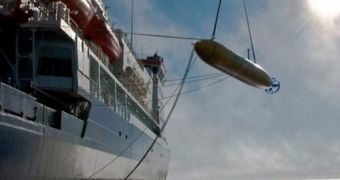On July 26, the German icebreaker Polarstern launched the autonomous underwater vehicle (AUV) Bluefin. The goal of the submarine was to dive in the ice-cold waters, and then conduct a variety of studies, while collecting samples at the same time. The endeavor, part of a unique Arctic study, was extremely successful, and experts are now in the process of decoding all of the information the AUV managed to retrieve. This was the first dive Bluefin made for scientific purposes, OurAmazingPlanet reports.
Bluefin is operated by researchers at the Alfred Wegener Institute for Polar and Marine Research (IPMR), which belongs to the Helmholtz Association in Berlin. It has a length of about 4 meter, or 13 feet, and features an impressive suite of scientific instruments, that in fact make it unique among AUV. According to IPMR expert Michael Lages, who is in charge of the department operating Bluefin, the machine's sensors, systems and instruments operated flawlessly during this first run, and so the team is excited about the possibilities that the advanced submarine opens up.
“We are one of the world's first working groups to have successfully carried out such an under-ice mission, a goal we have been working hard to achieve. The samples and data obtained will shed a new light on phytoplankton production in the transition area between the permanently ice-covered Arctic Ocean and its ice-free marginal zone. Autonomous underwater vehicles are opening up new possibilities to investigate the ice-covered polar seas – areas that are of pivotal importance in climate research,” says the chief scientist of the German expedition, Thomas Soltwedel.
The expert adds that the Bluefin was recovered by helicopter after completing its mission, which is something no other Arctic science group has done before. The AUV was then returned to the Polarstern (a name that is German for polar star). The icebreaker is a work of art in itself, featuring numerous research laboratories, refrigerated rooms, and cool aquariums for storing living samples. The ship let Norway for the Arctic on June 30, and it returned to Iceland's capital city of Reykjavik in July 29.

 14 DAY TRIAL //
14 DAY TRIAL //